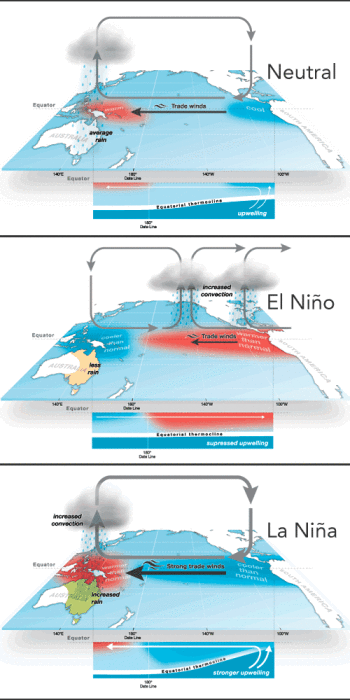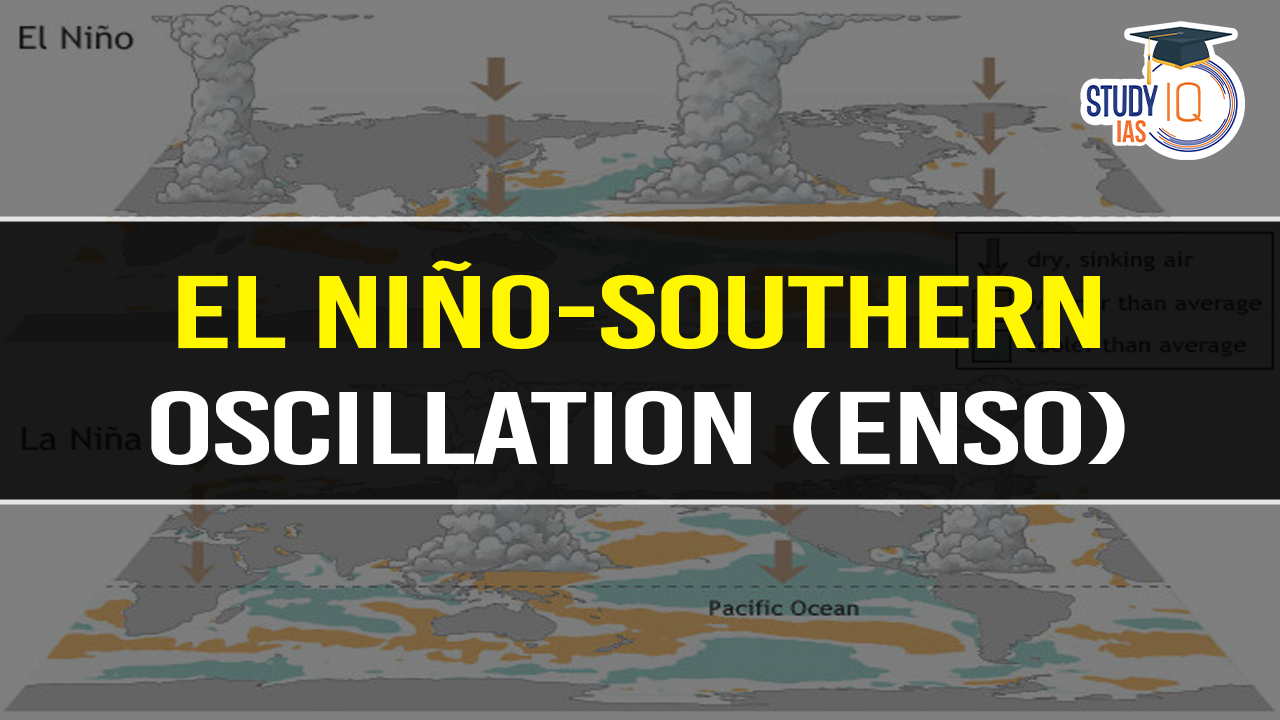Table of Contents
Context: The US-based National Ocean and Atmospheric Administration (NOAA) announced that the El Nino conditions that began in mid-2023 ended last month. El Nino conditions have been replaced by El Nino Southern Oscillation (ENSO) neutral conditions.
El Niño-Southern Oscillation (ENSO)
- ENSO is a recurring climate pattern involving changes in sea surface temperatures (SST) in the central and eastern tropical Pacific Ocean.
- The cycle occurs approximately every three to seven years, with surface waters warming or cooling by 1°C to 3°C compared to normal.
Phases of ENSO

El Niño
- El Niño is a climate phenomenon where a large area of water in the eastern tropical Pacific Ocean becomes abnormally warm.
- El Niño is declared when the eastern tropical Pacific temperature rises 0.5°C above the long-term average.
- Results in reduced rainfall over Indonesia and increased rainfall over the central and eastern tropical Pacific.
- The normal easterly winds weaken or reverse to westerly winds.
- The intensity of El Niño correlates with the degree of warming in ocean temperature anomalies.
- The specific trigger for El Niño is uncertain. A weakening of the normal westward-blowing trade winds is a key symptom.
- Impact: The phenomenon impacts global atmospheric circulation.
- It can weaken the Indian monsoon.
- It causes droughts in usually damp regions like parts of Indonesia and Australia.
- It brings increased rainfall to the western United States.
La Niña
- Marked by below-average SSTs in the central and eastern tropical Pacific Ocean.
- Leads to increased rainfall over Indonesia and decreased rainfall over the central and eastern tropical Pacific.
- The normal easterly winds strengthen.
- The intensity of La Niña is linked to the degree of cooling in ocean temperature anomalies.
ENSO-Neutral
- Neither El Niño nor La Niña conditions.
- Tropical Pacific SSTs are generally close to average.
- There are instances where the ocean may show signs of El Niño or La Niña, but the atmospheric conditions do not align, or vice versa.
Impact on Global Weather
- The ENSO cycle significantly influences rainfall distribution in the tropics.
- It affects weather patterns across the United States and other parts of the world, contributing to extreme weather events like floods, droughts, and altered storm activities.
Recent Weather Impact in India
- Heatwave Conditions: This year’s severe heatwave conditions over India were aggravated by the El Nino. Regions such as southern, eastern, northwestern, and northern India experienced prolonged heatwaves, with temperatures ranging between 45 to 51 degrees Celsius.
- Consequences: The extreme temperatures led to increased heat-related deaths and a surge in demand for water and power.
Future Projections
- La Nina Development: NOAA predicts the possible development of La Nina conditions from July to September, which may persist through the winter in the northern hemisphere from November to January.
- IMD Predictions: The India Meteorological Department (IMD) forecasts above-normal rainfall for the later half of the ongoing southwest monsoon season, influenced by La Nina and other oceanic factors. Typically, July and August are the rainiest months, contributing to nearly 70% of the seasonal rainfall in India.


 Places in News for UPSC 2025 for Prelims...
Places in News for UPSC 2025 for Prelims...
 Tobacco Cultivation in India: Relief to ...
Tobacco Cultivation in India: Relief to ...
 Countercyclical Capital Buffer (CCyB): P...
Countercyclical Capital Buffer (CCyB): P...





















